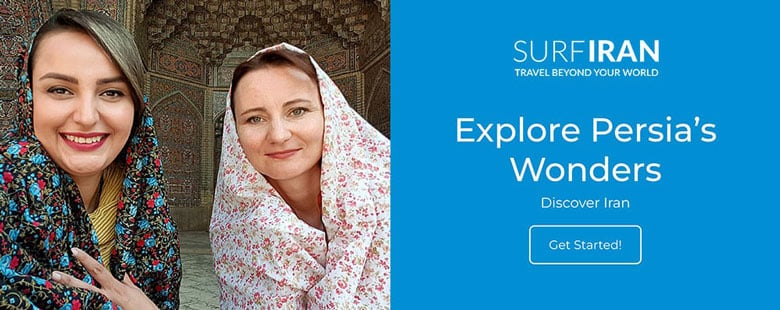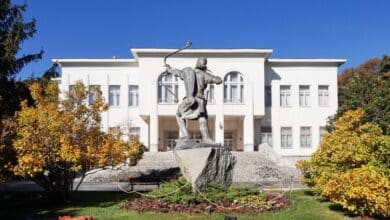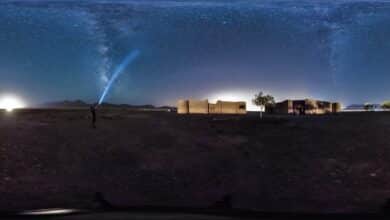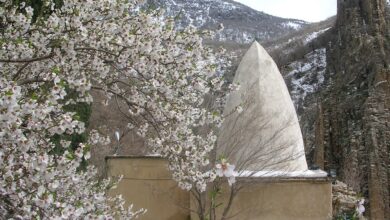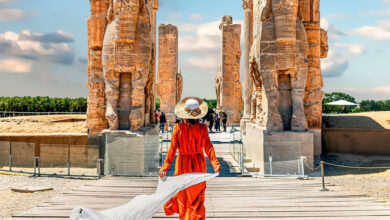Sheikh Lotfollah Mosque in Isfahan: An Architectural Masterpiece
Unveiling the Hidden Gem of Isfahan

Isfahan, a city rich in culture and history, is renowned for its mosques that serve as iconic representations of Iranian Islamic architecture. Among the notable mosques in Isfahan are the Jamẹ-Atiq-e Isfahan Mosque, Hakim Mosque, and Sheikh Lotfollah Mosque. These mosques not only serve as places of worship, but also as cultural and artistic hubs that encapsulate the narrative and heritage of the city. With its profound cultural legacy, Isfahan has consistently captivated enthusiasts of history and architecture worldwide.
Sheikh Lotfollah Mosque stands as a remarkable testament to Iranian architecture, crafted during the Safavid era. Situated on the eastern side of Naqsh-e Jahan Square in Isfahan, this mosque was skillfully constructed by the esteemed architect Mohammad Reza Esfahani. It serves as a splendid showcase of Iranian tile work and architectural prowess. The absence of a minaret in the mosque’s dome only enhances its allure, as the seven-colored tiles and the play of sunlight create a mesmerizing spectacle.
Contents
Sheikh Lotfollah Mosque General Information
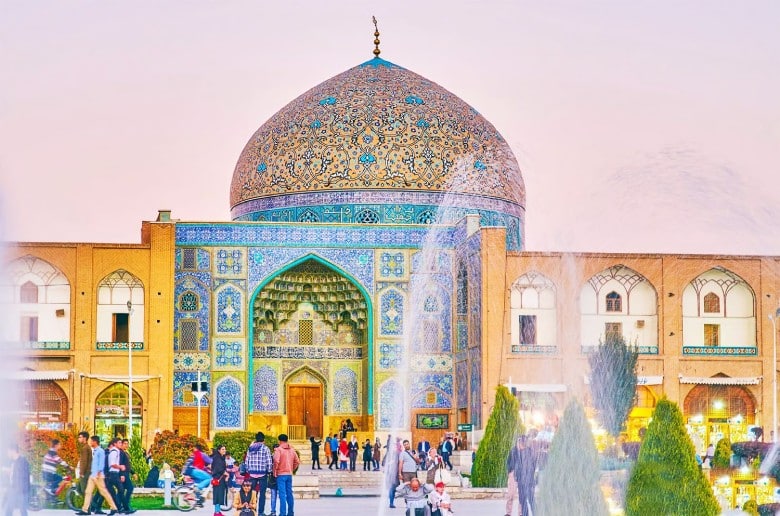
The mosque’s interior is adorned with intricate floral designs and elegant calligraphy, while its tiled altar indicates the Qiblah direction. Named after Sheikh Lotfollah Jabal Aamili, a renowned scholar of the Safavid era, this mosque is celebrated as a national treasure of Iran and a UNESCO World Heritage Site. The unique architectural features of Sheikh Lotfollah Mosque, such as sound reflection at a specific spot within the mosque, have established it as a significant tourist destination.
Many visitors from around the globe come to Isfahan annually to witness this masterpiece and appreciate its magnificence. Sheikh Lotfollah Mosque serves not only as a place of worship but also as a representation of Iran’s diverse history and culture. Renowned worldwide for its intricate and distinctive architecture, this mosque showcases the artistic talents of two calligraphers from the Shah Abbas era, Alireza Abbasi and Baqir Bana, through the elegant inscriptions and designs adorning its interior.
BOOK ONLINE
Isfahan Hotels
The Sheikh Lotfollah Mosque showcases remarkable architecture, intricate tiling, and exquisite decorations, exemplifying the finest artistry of the Safavid era. Its allure has captivated both local and international tourists for centuries. This grand edifice not only stands as a prominent landmark in Isfahan but is also hailed as one of the seven enigmatic wonders and a premier architectural marvel worldwide.
Construction of Lotfollah Mosque

The mosque is constructed on a quadrilateral base, which transforms into an octagonal shape at the upper part of the building, ultimately culminating in a circular dome. The walls of the mosque are exceptionally sturdy, designed to withstand the immense weight and pressure exerted by the dome. The tiling on the dome of the mosque showcases exquisite patterns and colors, making it one of the most stunning examples of tiling in Iranian architecture. Inside the Sheikh Lotfollah mosque, the tiling is adorned with mosaic tiles, adding to its beauty. Additionally, a number of marble tiles both inside and outside the dome are inscribed with the Sols calligraphy.
This mosque, unique in its design, lacks both a minaret and a nave, setting it apart from other mosques. The architectural style of the building follows the Isfahani style. At the entrance, two pillars crafted from plantain wood have stood the test of time for over four centuries. Additionally, a stunning octagonal pond graces the front of the mosque.
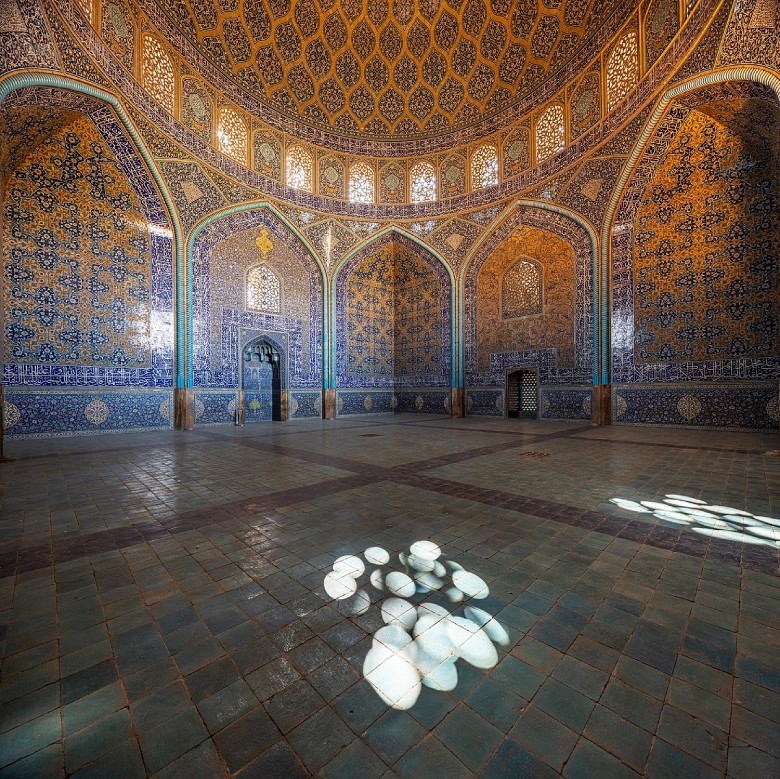
Jolo Khan Mosque (the front part of the mosque) is situated away from the eastern side of Naqsh-e Jahan square. Upon ascending four steps, one enters the main area. The lower section of the walls in this space is adorned with yellow marble, while the large side platforms are constructed from the same stone.
The Qiblah direction
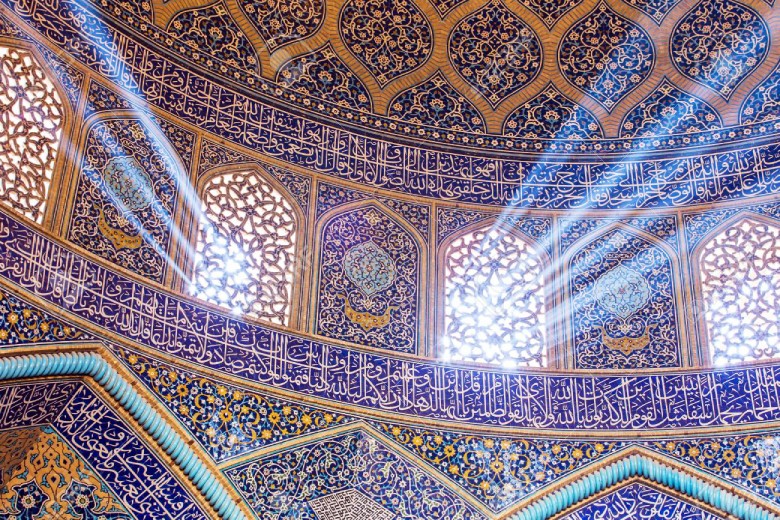
One distinguishing feature of this mosque is its unique architectural design, specifically the 45-degree turn it takes along the north-south axis, commonly referred to as the “heel“. This deliberate rotation serves a purpose – to ensure proper alignment with the Qiblah, the direction of prayer. Due to the mosque’s entrance being situated towards the east of the square, constructing the mosque in the same direction would have posed a challenge in orienting it towards the Qiblah. To overcome this obstacle, a clever solution was implemented: a corridor was created that veers left and then right from the very entrance of the mosque. As a result, although the mosque’s overall structure faces east and gives the impression of a north-south alignment, the wall enclosing the Mihrab, the prayer niche, is precisely directed towards the Qiblah.
The Dome of the Mosque

The Sheikh Lotfollah Mosque is adorned with a variety of decorative elements, including mosaic tiles, Islamic geometric motifs, large stars intertwined with ivy patterns, rhombus-shaped designs, floral and plant motifs, as well as calligraphy in Sols script. These Islamic decorations and art have been utilized to embellish various structures throughout different eras, holding a significant position. The dome of the Sheikh Lotfollah Mosque stands out among other domes, showcasing its magnificence, formal characteristics, and the intricate decorations adorning its surface.
Final Words
The Sheikh Lotfollah Mosque, an exquisite example of Safavid architecture, exudes a serene presence on the eastern side of Naqsh-e Jahan Square in Isfahan, Iran. This architectural masterpiece is a tribute to the skill of its designer, Mohammad Reza Isfahani, and the foresight of Shah Abbas I of Persia. Despite its modest size and absence of minarets, the mosque serves its intended purpose with grace and grandeur. The dome of the mosque, a blend of engineering and artistic brilliance, reaches a height of 32 meters, its exterior embellished with tiles that transition in color from cream to pink depending on the sunlight.
Sheikh Lotfollah Mosque FAQ
What are the specific features of Sheikh Lotfollah Mosque?
The Mihrab, located in the Qiblah direction, serves to point towards Mecca and is typically the most intricately decorated section of a mosque due to its significance.
Why was the Sheikh Lotfollah Mosque built?
it was constructed as a private mosque for the Safavid royal women,
What materials are used in the Sheikh Lotfollah Mosque?
The materials utilized in the construction of the Sheikh Lotfollah Mosque include marble for the lower façade and gateway, along with colorful tiles adorning the upper sections of the building.
